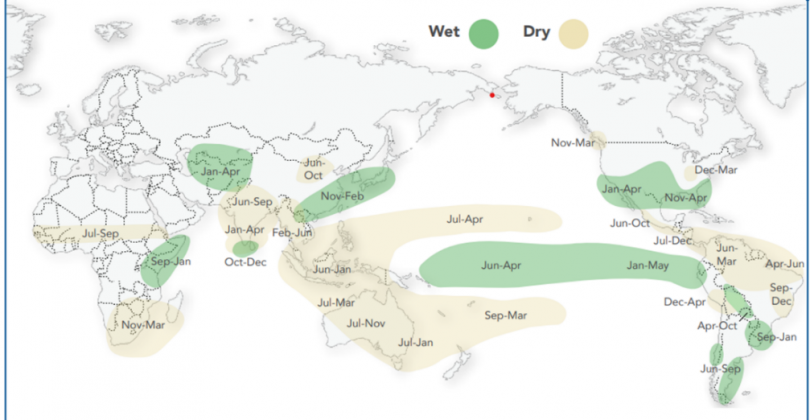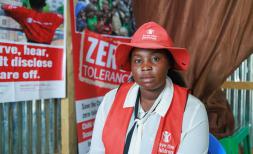EL NIÑO: WHAT IS IT AND HOW WILL IT IMPACT CHILDREN AROUND THE WORLD?

Aerial photos show the damage caused by floods that hit Southern Somalia on May 2023. Awale Koronto/ Save the Children
What is El Niño, what causes it, and what are its effects?
El Niño and La Niña represent extremes in the El Niño/Southern Oscillation Cycle (ENSO). ENSO is a natural weather phenomenon which causes fluctuations in sea surface temperatures, rainfall, air pressure, and atmospheric circulation in the Pacific Ocean.
El Niño typically lasts 9-12 months while La Niña typically lasts 1-3 years. They both tend to develop during March-June, reaching peak intensity during December-April. Both El Niño and La Niña are temporary and natural, but they can trigger extreme weather patterns around the globe.
El Niño is associated with the warming of the ocean surface temperatures in the central and eastern tropical Pacific Ocean off the coast of South America, whereas La Niña is the opposite, being associated with the cooling of the ocean’s surface. While every El Niño event is unique, they regularly cause an increase in global temperatures and lead to extreme weather events around the world.
Historically, El Niño events have had differing impacts across regions. However, no two El Niño are the same, and the full picture of how El Niño 2023 may impact weather patterns across the globe will become clearer over the coming months, following further forecasting and monitoring.

Source: IRI. 2023. ENSO Resources. International Research Institute for Climate Prediction, Columbia University. 2023.
Is El Niño caused by the climate crisis?
Although El Niño events are natural and cyclical, the impacts are being exacerbated by the climate crisis. El Niño 2023 is likely to trigger a new spike in global warming. In fact, it is increasingly likely that the critical 1.5ºC global warming threshold could be temporarily breached for at least one year within the next five years.
1.5ºC is a tipping point which scientists have warned that if surpassed, could have irreversible consequences, dramatically increasing the risk of food and water shortages, deadly extreme weather incidents and other crises such as conflict.
READ MORE: How is Save the Children taking action against the Climate Crisis?

Luciano, 12, standing by the devastation left by Cyclone Ana and floods in Malawi. Thoko Chikondi / Save the Children
How have el Niño events impacted children in the past?
The El Niño event of 2015/2016 impacted 60 million people across 23 countries. Millions of families were forced to leave their homes in search of food, water or work after extreme weather devastated crops and livelihoods.
Children had no option but to leave behind their loved ones, their schools and access to healthcare and other essential services. Some 6 million children were pushed into undernourishment. This is three times as many children that became undernourished as a result of the global COVID-19 pandemic.
At the same time, outbreaks of diseases including cholera, malaria and dengue, left undernourished children even more vulnerable to severe illness and even death.

Sreyvatey, 14, looking for plants near her home on Tonle Sap Lake, Cambodia. Save the Children.
El Niño in 2023 – could this be the worst year on record?
As of 8th June 2023, an El Niño event has been declared and the projected impacts paint a worrying picture for children across the world.
El Niño can trigger extreme weather events globally − from fierce droughts, wildfires and heatwaves to deadly flooding and tropical storms. The global economic fallout of El Niño is likely to also be huge, with a recent study estimating costs as high as $3.4 trillion.
With millions of lives already on the line as a result of the worst global food crisis in decades, the ongoing socio-economic fallout of the COVID-19 pandemic, and the worsening impacts of climate change, children may be more vulnerable to the effects of El Niño this year than ever before.
Children are more likely to face hunger, become severely malnourished or contract deadly diseases when they are cut off from nutritious food, safe water, sanitation facilities or healthcare.
They are more likely to be separated from their families in the chaos of a disaster or while seeking refuge. And when separated, they are at much higher risk of facing violence, abuse and exploitation.
They are more likely to face poverty and child protection risks when their families’ livelihoods are destroyed by floods. It is their futures that are threatened when storms batter their schools, or they are forced to drop out of education due to drought-induced displacement.
It is unacceptable that in 2023 children’s lives are being torn apart by predictable changes in climate like this.
How will this year’s El Niño impact children in different regions across the world?
We know those hit hardest by the effects of El Niño will also be in regions already bearing the brunt of multiple crises, like conflict, climate-related disasters and skyrocketing food prices.
Seasonal forecasts indicate El Salvador, Guatemala, Honduras and Nicaragua will be facing a high likelihood of below-average rainfall and above-average temperature and a poor crop yield in 2023. Children and families could face skyrocketing food prices and critical levels of hunger if the basic stock of key grains and food is not maintained.

Maria Elena, 12, walking home with her sister-in-law Maria, 24 in Guatemala.
Meanwhile, in Haiti, current projections reveal an increased risk of flooding and landslides. This is a country which is already experiencing a complex humanitarian crisis as a result of ongoing violence, political and economic turmoil, food insecurity and disease outbreaks.
In Peru, there are fears that a current dengue outbreak could spiral out of control as a result of this year’s El Niño, which increases rains and mosquitoes.
In the Horn of Africa, El Niño is historically associated with above-average rain during the rainy season. However, rains on the parched ground following almost three years of drought bring further risks of flooding, displacement, food shortages and disease.
What should the international community be doing?
The impacts of the onset of El Niño will likely have large human and economic costs, further compounding humanitarian crises across the world over the next few months.
The window of opportunity to avert widespread devastation across multiple countries is closing. By acting now, we can help communities prepare for the worst impacts to better protect children’s lives and reduce the long-term implications. The international community must:
Manage the risk, not the crisis: The entire intentional community − governments, donors, UN agencies, NGOs, and local civil society organisations − need to act decisively on information from early warning systems now, so that help reaches families sooner.
Immediately commit increased, flexible funding for early action: Despite 50% of crises being somewhat predictable today, less than 1% of humanitarian funding is allocated to early action based on risk information.
Commit increased funding for local and national responders: Effective anticipatory action is built at a local level, where risks and impacts on communities are best understood and responded to.
Put children at the centre: As children are always the most vulnerable in a crisis, they must be central to the design and implementation of all anticipatory action.
Commit to new and additional climate finance for loss and damage adaptation: Although El Niño is a natural phenomenon, the onset and impacts of the weather event are aggravating the existing climate crisis. Governments from high-income countries that have contributed most to the climate crisis, must commit new and additional funding to support countries who have contributed the least, yet are being hardest hit by the devastating impacts of climate-related disasters.
Amran (second from left) with her mother Amina and five siblings outside their tent in a camp for people displaced by the floods in Beledwayne, Somalia
How is Save the Children responding?
This crisis, unlike many others, is predictable. We have the tools to project the impacts it will have on children and are mobilizing now to protect them. If we wait until a disaster hits, it is too late.
We’re actively monitoring forecasts and potential risks across regions and working with partners to help communities anticipate, prepare for and prevent the worst possible humanitarian impacts.
We’re supporting communities to access early warning information so that they can take preventative measures. For example, sharing messaging with families on how to reach safe spaces in time ahead of flooding, etc.
We’re ensuring the continuity of essential services − such as healthcare facilities, schools and child protection systems.
We’re building and strengthening social protection systems to mitigate the worst socio-economic knock-on effects. For example, providing drought-tolerant crops and livestock vaccinations to farmers ahead of an anticipated failed rainy season to protect yields and food security. Or distributing cash to families ahead of anticipated flooding which could damage homes or cut them off from essential services and income sources.
Through all our work, we’re also championing the leadership of national and local organizations in designing and implementing risk-informed plans and activities and we’re collaborating with communities, governments, meteorological and research institutions.
How can you help?
While children are the most vulnerable to crises like this, they are also extremely resilient. With the right support, they can overcome even the most unimaginable challenges.
By donating to our Children’s Emergency Fund, you can help us prepare better, respond faster, and protect children for longer. Your donation will help us keep children safe, healthy, nourished and learning, even in the face of the extreme challenges they will face this year.








